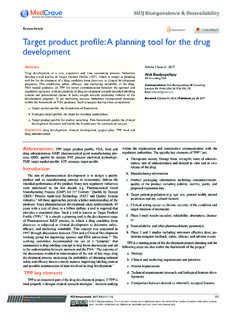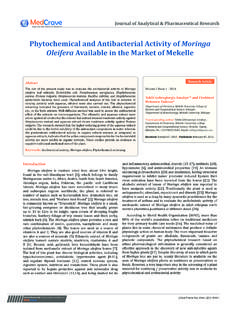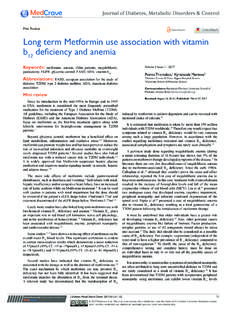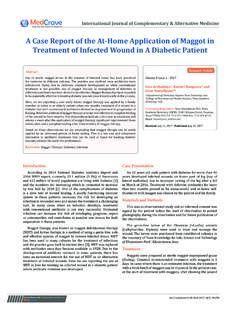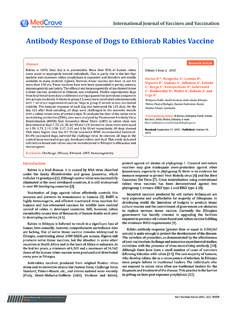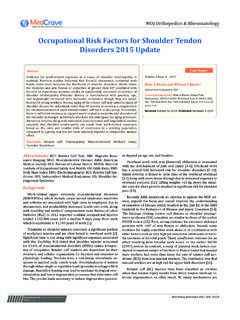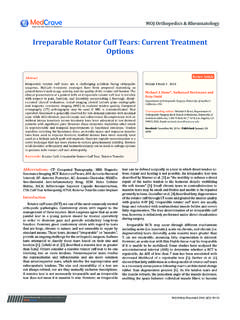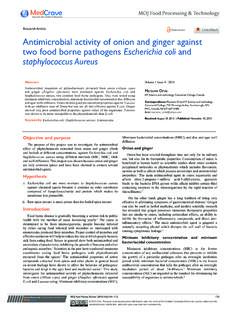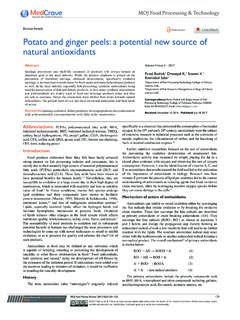Transcription of Osteopathic manipulation for pubic symphysis …
1 Submit Manuscript | symphysis dysfunction is a common condition in ,2 The hormone relaxin has a primary softening effect on the ,4 This, in combination with the center of gravity changes of the enlarging uterus, causes strain patterns in the ligamentous tissues that the patient may not be able to overcome Most pubic symphysis dysfunction involves a vertical shear, is minor,6 and is easily treated with simple Osteopathic manipulation 9 Anterior/posterior shears are more rare, but cause much more pain and Additionally, significant trauma due to the shears is often in the patient reportThe patient, at term, was noted to be 4 centimeters (CM) dilated, 90% effaced and 0 station with regular painful contractions. In addition, she had been having pubic symphysis pain for several months that had not been treated. In addition to pelvic pain, she had difficulty with normal activities such as walking and lifting her feet.
2 Her physician was notified of admission in spontaneous labor . The obstetrician (OB) hospitalist was an Osteopathic physician, and requested permission to treat the patient from the attending physician with Osteopathic manipulation which was approved. The patient was verbally consented for the procedure. Structural examination revealed an exquisitely tender pubic symphysis with both vertical and anterior posterior shears noted. There were restrictions in range of motion of the sacroiliac joints bilaterally, worse on the patient s right. Asymmetry of the anterior superior iliac spines was also noted. Muscle energy technique was used to correct the anterior/posterior pubic shear, and a leg tug was used to correct the vertical component. Direct myofasical release was used to restore equal range of motion of the sacroiliac joints, then was used to correct restrictions in the suprapubic fascia.
3 Symmetry of the pelvic structures was restored, the patient reported a significant decrease in pain, and was able to lift her feet when ambulating. She was advised to seek Osteopathic treatment after the delivery, as there is often an exacerbation of symptoms because of the stress on the symphysis with vaginal delivery. Her physician was advised to order a trochanter belt for the patient after delivery for pelvic patient received epidural anesthesia and successfully completed a vaginal delivery. After delivery, the patient was being assisted to move in bed before full sensation had returned to her legs, and one leg inadvertently dropped off the bed. The patient immediately felt her symptoms return. There was no one available at the time to give treatment. An abdominal binder rather than a trochanter belt was ordered which did not provide relief to the patient.
4 After discharge, she used a walker belonging to an elderly relative for ambulation. Five days after the delivery, still in significant pain and unable to ambulated independently, she contacted the hospitalist who had treated her for assistance in finding follow medical students are well versed in vertical pubic shear, although anterior/posterior shears, being much less common, may go unrecognized. Allopathic physicians may not be familiar with pubic shear, so symptoms may be regarded as part of usual discomforts of pregnancy. If recognized, the physician may not be aware of treatments available or may be reluctant to refer for Osteopathic and symptoms Patients with mild pubic shear may report a pinchy pain in the anterior mid pelvis that is exacerbated by The pain is constant, and when presenting to triage for evaluation, the constant nature of the pain distinguishes pubic shear from signs and symptoms of labor .
5 History may include pain beginning when arising from a seated position or getting out of bed. It may occur with bending and twisting, getting into a car one leg first or arising from a seated position with one leg in front of the other. Anterior/posterior shear causes deep severe pelvic pain, as the pelvic diaphragm has unequal tensions from side to side. The patient may have history of trauma such a motor vehicle accident, a fall or obstetric injury. A shear may be induced at the time of delivery if the patient has regional anesthesia MOJ Womens Health. 2017;5(2):213 2017 Showalter et al. This is an open access article distributed under the terms of the Creative Commons Attribution License, which permits unrestricted use, distribution, and build upon your work manipulation for pubic symphysis dysfunction during spontaneous labor : a case studyVolume 5 Issue 2 - 2017 Showalter A, McCarroll MLDepartment of Clinical Medicine, Pacific Northwest University, USAC orrespondence: Michele L McCarroll, , CCRP, ACSM-CCEP, FAACVPR, Chief Research OfficerProfessor of Clinical Medicine, College of Osteopathic Medicine, Pacific Northwest University of Health Sciences, Office of Scholarly Activity, Iron Horse Lodge 2nd Floor, 111 University Parkway, Suite 202, Yakima, WA 98901, USA, Tel 509 249 7730, Email June 07, 2017 | Published: June 16, 2017 AbstractPubic symphysis dysfunction is a common condition in pregnancy.
6 Most pubic symphysis dysfunction involves a vertical shear, is minor, and is easily treated with simple Osteopathic manipulation techniques. The obstetrician (OB) hospitalist was an Osteopathic physician, and requested permission to treat the patient from the attending physician with Osteopathic manipulation which was approved. Direct myofasical release was used to restore equal range of motion of the sacroiliac joints, then was used to correct restrictions in the suprapubic fascia. Symmetry of the pelvic structures was restored, the patient reported a significant decrease in pain, and was able to lift her feet when Women s HealthCase ReportOpen AccessOsteopathic manipulation for pubic symphysis dysfunction during spontaneous labor : a case study214 Copyright: 2017 Showalter et : Showalter A, McCarroll ML. Osteopathic manipulation for pubic symphysis dysfunction during spontaneous labor : a case study.
7 MOJ Womens Health. 2017;5(2):213 215. DOI: during second stage unequal pressures are placed on the patient s legs while assisting her. The symphysis will be exquisitely tender on the side of examOsteopathic physicians diagnosis somatic dysfunction with tenderness, asymmetry, restrictionof motion, and tissue texture changes (TART) findings. Any of the following findings in tissue is indicative of somatic dysfunction :i. Tenderness (T),ii. Asymmetry (A),iii. Restriction of motion (R),iv. Tissue texture changes (T). The structural examination of the pelvis should include evaluation of the anterior superior iliac spines for symmetry. The pubic symphysis is then palpated for tenderness, and thumbs placed on the superior border of the pubic bones will show whether one side is more superior to the other, indicative of a vertical shear. The corresponding anterior superior iliac spine will also be superior in vertical pubic shear.
8 To evaluate for anterior/posterior shear, thumbs are placed on the anterior surface of the pubic symphysis equidistance from the midline. Again, symmetry or asymmetry is determined. If an anterior/posterior shear is present, one side will be more posterior, and the side of dysfunction will be exquisitely tender. Testing sacroiliac dysfunction can be done by using compression of the iliac crest into the sacroiliac joint. Normally there is a subtle springing, or giving way with compression. If one side does not spring, that is the side of dysfunction . The sacrum may also be checked for sacral torsion or other Osteopathic techniques are applied to correct TART findings with the goal of restoring full range of motion, symmetry and relieving pain. The specific treatments applied to this case will be discussed. When a significant dysfunction such as anterior/posterior shear is encountered, it is often necessary to correct some of the surrounding dysfunction before the primary problem is addressed.
9 In this case, the anterior superior iliac spine asymmetry was treated with facilitated positioning. The patient was placed with legs in a figure of four fashion, straight leg on the more inferior side. The operator places sufficient downward force on the bent knee so the patient must engage pelvic muscles to straighten her leg. This rotates the iliac crest of the straight leg posterior, also elevating the pubic symphysis and partially corrected the vertical shear. A gentle leg tug was then done on the superior side to complete treatment of the vertical shear. Muscle energy techniques also utilize patient muscle engagement to create a change in the target tissue. With the patient in semi-Fowler s position, the knee of the posterior pubic symphysis was bent and internally rotated to come past midline until resistance was encountered. The patient was asked to gently push against the operator s resistance in external rotation.
10 When the patient relaxes, the leg may be passively moved to a new position of ease. This is repeated several times, progressively increasing internal rotation of the extremity and altering muscle tension. The last time, the patient s leg is passively straightened while keeping it in internal rotation. The muscle engagement necessary for this activity also brings the pubic symphysis on that side more anterior. The symphysis is rechecked and the procedure repeated if necessary. The effect of an anterior/posterior shear, in addition to pelvic floor dysfunction , includes strain patterns in the suprapubic tissues. After treatment of the shear, myofasical release treatment of the suprapubic tissues first is very tender, but after a few minutes provides significant relief of discomfort. The patient s sacroiliac dysfunction was treated with a passive full range of motion of the joint. It is important to address all identified somatic dysfunction with anterior/posterior shear to provide tissue stability and prevent recurrence of the Long-standing dysfunction does tend to recur, but the more thorough the treatment, the longer it takes to recur.
